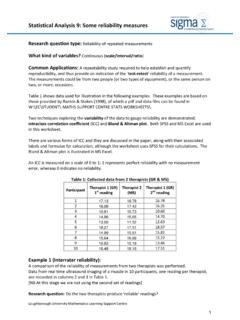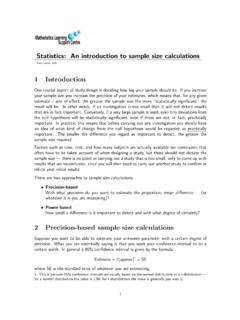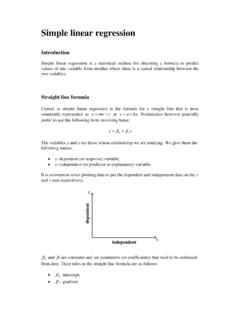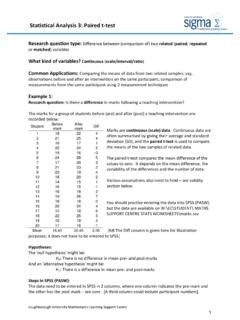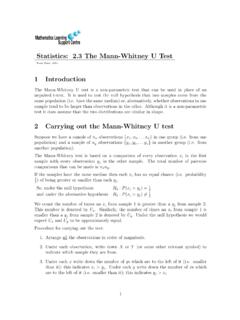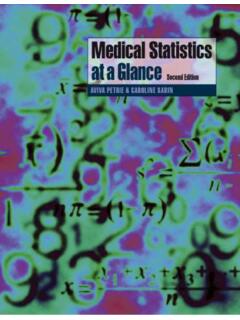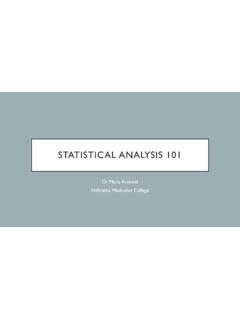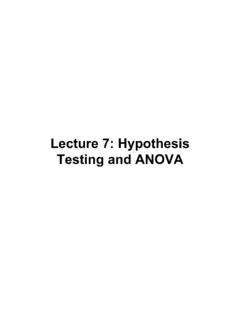Transcription of Statistics: 2.2 The Wilcoxon signed rank sum test
1 Statistics: The Wilcoxon signed rank sum testRosie Shier. IntroductionThe Wilcoxon signed rank sum test is another example of a non-parametric or distributionfree test (see The Sign Test). As for the sign test, the Wilcoxon signed rank sum testis used is used to test the null hypothesis that the median of a distribution is equal tosome value. It can be used a) in place of a one-sample t-test b) in place of a paired t-testor c) for ordered categorial data where a numerical scale is inappropriate but where it ispossible to rank the Carrying out the Wilcoxon signed rank sum testCase 1: Paired data1. State the null hypothesis - in this case it is that the median difference, M, is equalto Calculate each paired difference,di=xi yi, wherexi,yiare the pairs of rank thedis, ignoring the signs ( assign rank 1 to the smallest|di|, rank 2 tothe next etc.)4. Label each rank with its sign, according to the sign CalculateW+, the sum of the ranks of the positivedis, andW , the sum of theranks of the negativedis.
2 (As a check the total,W++W , should be equal ton(n+1)2, wherenis the number of pairs of observations in the sample).Case 2: Single set of observations1. State the null hypothesis - the median value is equal to some value Calculate the difference between each observation and the hypothesised median,di=xi Apply Steps 3-5 as the null hypothesis, we would expect the distribution of the differences to be ap-proximately symmetric around zero and the the distribution of positives and negativesto be distributed at random among the ranks. Under this assumption, it is possible to1work out the exact probability of every possible outcome forW. To carry out the test,we therefore proceed as follows:6. ChooseW= min(W ,W+).7. Use tables of critical values for the Wilcoxon signed rank sum test to find theprobability of observing a value ofWor more extreme. Most tables give both one-sidedand two-sided p-values. If not, double the one-sided p-value to obtain the two-sidedp-value.
3 This is an exact approximationIf the number of observations/pairs is such thatn(n+1)2is large enough (>20), a normalapproximation can be used with W=n(n+ 1)4, W= n(n+ 1)(2n+ 1)24 Dealing with ties:There are two types of tied observations that may arise when using the Wilcoxon signedrank test: Observations in the sample may be exactly equal to M ( 0 in the case of paireddifferences). Ignore such observations and adjustnaccordingly. Two or more observations/differences may be equal. If so, average the ranks acrossthe tied observations and reduce the variance byt3 t48for each group ofttied :The table below shows the hours of relief provided by two analgesic drugs in 12 patientssuffering from arthritis. Is there any evidence that one drug provides longer relief thanthe other?CaseDrug ADrug BCaseDrug ADrug :1. In this case our null hypothesis is that the median difference is Our actual differences (Drug B - Drug A) are:+ ,+ ,+ , ,+ , ,+ , ,+ ,+ ,+ ,+ actual median difference is Ranking the differences and affixing a sign to each rank (steps 3 and 4 above) +-++++++++2 CalculatingW+andW gives:W = 1 + 2 + 4 = 7W+= 3 + + + 7 + 8 + 9 + 10 + 11 + 12 = 71 Therefore, we haven=12 132= 78W= max(W ,W+) = can use a normal approximation in this case.
4 We have one group of 2 tied ranks, sowe must reduce the variance by8 248= We get:z=71 12 134 12 13 2524 39 gives a two-sided p-value ofp= There is strong evidence that Drug B providesmore relief than Drug Carrying out the Wilcoxon signed rank sum testin SPSS ChooseAnalyze SelectNonparametric tests Select2 Related Samples Specify which two variables comprise your pairs of observation by clicking on themboth then clicking on the arrow to put them underTest Pair(s) List. UnderTest TypeselectWilcoxon If you want exact probabilities ( based on the binomial distribution), click onExact, chooseExact, thenContinue Click onOKThe output will look like this:RanksN Mean rank Sum of RanksDrug B - Drug A Negative DRUGB<DRUGAb. DRUGB>DRUGAc. DRUGA = DRUGBTest StatisticsbDRUGB - DRUGAz Sig. (2-tailed) Sig. ( Sig. ( Based on negative ranksb. Wilcoxon signed Ranks Test3))

